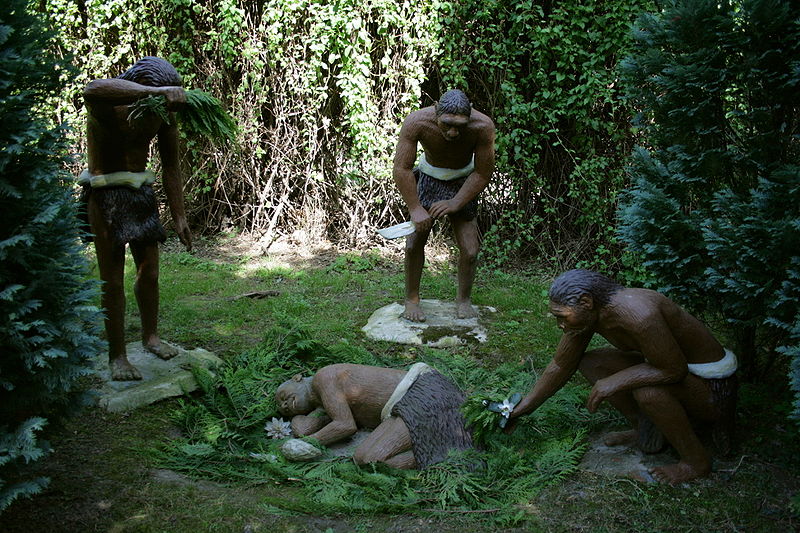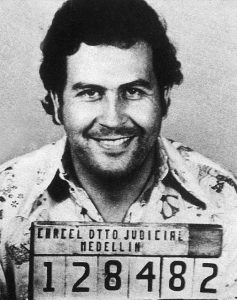As children, most of us picture Neanderthals as the archetypal caveman even though Neanderthals are the most recent archaic humans to Homo sapiens. First emerging between 300,000 and 100,000 years ago, Neanderthals lived in a landscape filled with limestone caves. Because limestone is an excellent preserver of bones, we know more about Neanderthals than any other archaic human group.1 Archaeologists have been studying Neanderthal sites since the mid-1850s. We know how they lived, what they ate, how they hunted, the tools they used and how those tools changed over time, and what they wore.2 We even know that they buried their dead. Or did they? Archaeologists have been studying this possibility for over one-hundred years and still cannot seem to agree on the matter.
The controversy over Neanderthal burial of the dead began with the discovery of a body in a cave in La Chapelle-aux-Saints in southwest France, originally found in 1908. It was the first intact body found buried in the limestone caves frequently used by the Neanderthals as homes. A debate quickly arose among archaeologists to determine if the body had been buried or if it was simply an ancient body dump. A private team was hired to reexamine the evidence from the original excavation and they found the burial to be authentic because the body was not in a natural formation but had, in fact, been placed in a grave dug by human tools.3 Re-excavation of the cave revealed more Neanderthal bones and teeth, tools, and animal remains. Scientists were able to conclude that since the animal bones found in the cave showed signs of scavenger activity and the buried body did not, the body must have been buried quickly after death to have prevented normal scavenger activity. They also found no weathering on the Neanderthal bones from the burial site, but they did find weathering on the animal bones found loose in the cave, further implying that the body had been buried soon after death.4
The Shanidar Cave in the Kurdistan area of northern Iraq is a Neanderthal cave where eight adults and two infants were found buried in a grouping of graves. The Shanidar skeletons and grave sites have been well studied by archaeologists who have made several assumptions about Neanderthals based on the findings. One of the graves contained pollen from flowers that could only have come from a mountain range near the Shanidar Cave. Archaeologists believe that this is evidence that the body was either buried with flowers or the flowers were placed upon the grave after the burial, much like modern humans do at funerals. Another one of the Shanidar skeletons shows extensive injuries that had healed before death. This demonstrates that not only did the Neanderthal have some basic first aid skills, but they took care of their sick and injured. Archaeologists claim that this is suggestive of the Neanderthals possessing a complex social society.5
Excavations at the La Ferrassie location began over one-hundred years ago and have revealed seven Neanderthal skeletons, of which five are children. Examination of the burial sites at La Ferrassie demonstrate that all of the bodies were deliberately buried.6 Archaeologists have also revealed that the bodies were all found in what appears to be a cemetery type layout, with all the bodies oriented with their head facing east and feet facing west. The adult male, the most complete Neanderthal skeleton to date, shows that he was buried in a shallow grave in a fetal position with three rocks placed on his head. He also had flint tools and pieces of animal bones in his grave. The adult female was also in a fetal position, possibly tied with ropes, and placed in a small grave. The children were all buried with scrapers and pointed tools.7

At the Le Moustier site, several graves have been found, all of them shallow with the body in a fetal position. One particular grave contains the body of a young Neanderthal boy buried with flints under his head as if a pillow, an ax in his hand, an ox skull near his head, and cattle bones spread around him. What made this unusual was the finding that some of the cattle bones had been charred. Scientists have wondered if the charred bones were a sign of a funeral feast or provisions for the afterlife, both of which indicate that Neanderthals had a more complex social system than originally believed.8

Other burials in the area occupied by Neanderthals show similar attributes. In Uzbekistan, at Teshik Tash, a young Neanderthal boy was found buried with forty goat horns circling his body, points driven into the ground. At Saint-Cesaire, a Neanderthal adult was found buried with stone tools, some in his hands as if being used. A burial in Spy shows evidence of a fire on the top of the grave site, although archaeologists are not sure the intent of the fire. Mounting evidence shows that Neanderthals buried their dead much like other ancient cultures.9 Nothing demonstrates this more than the finding at Des-Cubierta Cave.
The Des-Cubierta Cave, north of Madrid, holds what archaeologists say is the first firm evidence of Neanderthal funerals. A series of small fires has been discovered surrounding a burial site of a young child known as Lozoya Child. All that has been found of the toddler is a jaw bone and six teeth that date back approximately 38,000 to 42,000 years ago. The child was buried with stone tools as well. Archaeologists found in each fire a horn or antler from local herbivores, aurochs, bison, and red deer to be exact. There was also a rhinoceros skull nearby.10
When examining the evidence gathered from the Lozoya Child and found at Des-Cubierta Cave, anthropologists have come to the conclusion that the cave was used as a specific place to mourn and remember the dead. They argue that the position of the bones and the stone tools found with the body, indicate it was not a random placement nor that cave was a dwelling and the tools just happened to be where the body landed. Anthropologists believe the layout of the cave, the location of the approximately 30 fires with horns or antlers, and the placement of the skull, all have the appearance of a place where rituals took place, or at the very least the cave held symbolic significance to the Neanderthal in the area.11 Archaeologists had found some caves with bones and antlers in Israel and Syria, but nothing as elaborate as the cave at Des-Cubierta.
A good archaeologist knows that when excavating old sites, it is always difficult to determine if the items found in a grave were put there on purpose or if they fell in by accident. It is even possible that the items just happened to be laying on the ground when the body was put there. Some archaeologists argue that Neanderthal burials and funerals are just a modern interpretation of what happened, a desire to place our belief system on an archaic human.12 In the case of the fire at the Spy burial, it could just simply be a fire that was built on top of a long forgotten grave. The pollen at the Shanidar grave could have been there long before the body was placed there. Or it is possible it was from flowers placed there to mask the odor of decaying bodies?
An example of this can be found at Rod de Marsal where a complete skeleton of a Neanderthal child was excavated in 1961. This burial was long used to support the argument in favor of Neanderthals burying their dead; however, modern archaeology tools and techniques have changed that idea. It is now widely accepted that the child simply fell through a crevice into a natural pit from above along with the tools found near him.13 Some archaeologists would argue that if we are wrong about one burial, how many others have we gotten wrong over the last century?
The reason so much emphasis is placed on Neanderthal burials is not so much to determine if they buried their dead or even how they buried them. Today scientists commonly accept that Neanderthals did bury their dead otherwise the number of graves would be much smaller.14 If Neanderthals simply wanted to dispose of the dead away from the campsite, they could have just carried them off a distance or thrown them into a ravine, problem solved. But we know that they buried their dead; that is not any longer the question to ask. What does matter is why they buried them.15

We know that Neanderthals lived in social groupings and they decorated their bodies and used complex tools that changed over time. All of this is proof that Neanderthals had social and cultural traditions.16 Burials are considered a key feature of human behavior, but funerals are considered a feature of the belief in an afterlife. If Neanderthals actually had funerals for their people, then there is an assumption that they did this for one of two reasons: to remember their departed loved one as we do today, or to leave the body with the items it needed to pass into the afterlife. In either case, a funeral is a symbolic act and if Neanderthals were holding funerals, they are more complex and have a higher society than scientists had believed.17
- Britannica School, January 2015, s.v. “Neanderthal,” by Erik Trinkaus and Russel Howard Tuttle. ↵
- Britannica School, January 2015, s.v. “Neanderthal,” by Erik Trinkaus and Russel Howard Tuttle. ↵
- Zach Zorich, “Did Neanderthals Bury Their Dead?” Archaeology 67, no. 2 (March/April 2014): 19. ↵
- Kate Wong, “Ancient Burial,” Scientific American 310, no. 3 (March 2014): 19. ↵
- Owen Edwards, “The Skeletons of Shanidar Cave,” Smithsonian Magazine 38, no. 6 (March 2010): 18. ↵
- Michael Balter, “Did Neanderthals Truly Bury Their Dead?” Science 337, no. 6101, (September 2012): 1443-1444. ↵
- Paul Jordan, Neanderthal (United Kingdom: Sutton, 1999), 102-106. ↵
- Paul Jordan, Neanderthal (United Kingdom: Sutton, 1999), 100. ↵
- Paul Jordan, Neanderthal (United Kingdom: Sutton, 1999), 97-102. ↵
- Richard Gray, “First Known Neanderthal Burial Rituals,” New Scientist 232, no. 3093, (October 2016): 14. ↵
- Richard Gray, “First Known Neanderthal Burial Rituals,” New Scientist 232, no. 3093, (October 2016): 14. ↵
- Michael Balter, “Did Neanderthals Truly Bury Their Dead?” Science 337, no. 6101, (September 2012): 1443-1444. ↵
- Michael Balter, “Did Neanderthals Truly Bury Their Dead?” Science 337, no. 6101, (September 2012): 1443-1444. ↵
- Michael Balter, “Did Neanderthals Truly Bury Their Dead?” Science 337, no. 6101, (September 2012): 1443-1444. ↵
- Michael Balter, “Did Neanderthals Truly Bury Their Dead?” Science 337, no. 6101, (September 2012): 1443-1444. ↵
- Paul Jordan, Neanderthal (United Kingdom: Sutton, 1999), 100. ↵
- Michael Balter, “Did Neanderthals Truly Bury Their Dead?” Science 337, no. 6101, (September 2012): 1443-1444. ↵



36 comments
Lauryn Hyde
This article was very interesting considering I have little knowledge about the Neanderthals. The findings about their burial traditions go to show how we may think modern civilization to be completely different from them however we have much in common. Their burial of the deceased is what we still do tody as well as placing flowers on the graves.
Alejandra Mendez
This is a very interesting topic. I’ve heard of Neanderthals from previous history classes I’ve taken, but from my understanding, they didn’t do many things we present day humans do such as burials. I always believed they just stayed in caves, hunted, and didn’t do much beyond that. This information is new to me because I never would have imagined them burying their people. What is even more surprising to me is that not only did they bury their people, but they also went as far as to lay them with flowers as evidence from the discoveries showed.
Veronica Spryszynski
Very informative article, I didn’t know much about Neanderthals until now. I do agree that they had rituals when burying the dead, especially because of all the tools found and how the horns were placed in a circle around the body, it is her to believe that those items could just fall into that place by itself. I hope they make more discoveries so we can learn more about their life.
Justin Garcia
This was a very interesting article. Though we researched many traits of Neanderthals it’s hard to say we know everything about them. We look back and notice more traits of them that show how capable they really were. They hunted very effectively and found ways to make or find shelter in a very short amount of time. All in all Neanderthals held alot of knowledge and I can’t help but be amazed the more we find out about our ancestors.
Cameron Ramirez
I have always found such interest in the Neanderthals and our early human ancestors. It is so amazing that we can find these bones in caves and determine so much from just things left behind or even buried in this situation. The topic on if the Neanderthals buried their dead has been up for discussion for many years. Your article was able to explain that indeed they did bury their dead. Overall, your article flowed well and made alot of sense to me. Keep up the good work, and I hope to read more articles from you.
Josemaria Soriano
The subject of the Neanderthals is very intriguing to me. The Neanderthals, men and women who became very similar to us, at least in terms of their appearance and their abilities. They lived in very cold, glacial times, in very harsh conditions, but they knew advanced techniques of survival that would leave almost anyone of today as ignorant. It is a mystery why they disappeared. They lived with us, the “modern” humans for about 40,000 years. But I’m going to tell you something that really shocks me. These Neanderthals had a cranial capacity of 1550-1600 cubic centimeters (cc). The capacity or volume of the skull has always been linked to intelligence by all anthropologists. Do you know how much capacity we have? About 1250 cc. This could indicate that they really could be smarter than us. For those who think that they were very primitive and that this is impossible, to say that it is already well demonstrated that they thought about death (for the funeral rituals they did) that they had very advanced tools, and that they evidently talked among themselves. This is something really surprising, since it challenges our concept that everything old to us is more primitive.